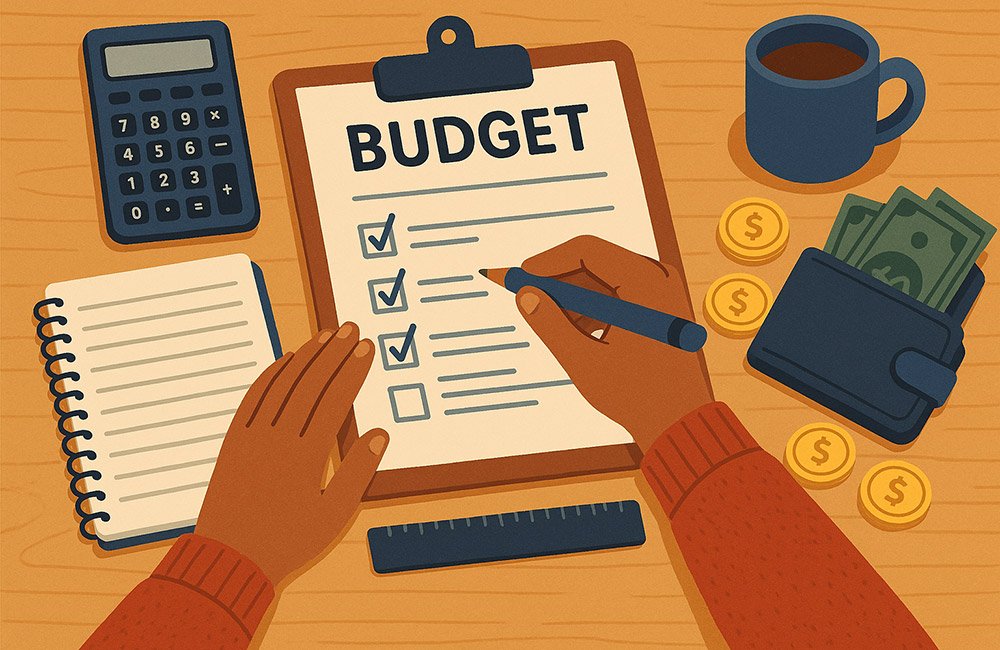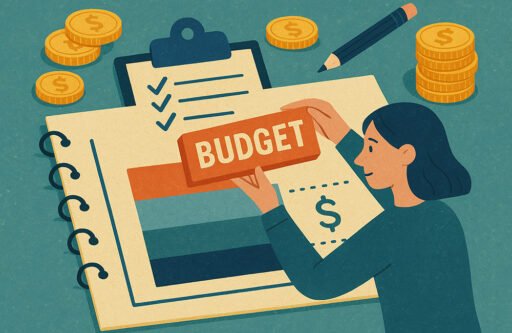Table of Contents
Introduction
Ever feel like no matter how many times you “start budgeting,” it just never sticks? You’re not alone. Most of us have been there — that point where your salary arrives, bills vanish half of it, and somehow you’re wondering, “Where did the rest go?”
But here’s the truth: a budget that works isn’t about strict rules or boring spreadsheets. It’s about building a plan that fits your real life — not a fantasy version of it.
So let’s break down how you can create a budget that not only helps you save but also lets you live comfortably, without guilt.
Start by understanding where your money actually goes
Before you even write down numbers or download a budgeting app, take a deep breath — and look at your spending for the past 2–3 months. Go through your bank statements, receipts, or even your digital wallet history.
You’ll notice patterns — maybe those daily coffees or late-night food orders that didn’t seem like much at the time. Once you see where the leaks are, it becomes easier to fix them.
| Expense Type | Average Monthly Spend | Can You Reduce It? |
|---|---|---|
| Food & Groceries | $300 | Maybe cook more at home |
| Entertainment | $150 | Limit streaming subscriptions |
| Transport | $120 | Use public transit sometimes 🚲 |
| Miscellaneous | $100 | Keep a small emergency buffer 💡 |
This simple overview already helps you see where your money’s been slipping through the cracks.
Decide what “a budget that works” means for you
Everyone’s “budget that works” looks different. For some, it’s paying off debt fast. For others, it’s saving for travel or a dream home. The key is to make your goals clear.
Ask yourself:
- What do I want my money to do for me?
- Do I value freedom, comfort, or security more?
- What am I willing to cut back on — and what am I not?
If you hate living like a monk, then don’t build a budget that feels like punishment. A sustainable budget is one that you’ll actually follow month after month.
Use the 50/30/20 rule — or your own version of it
This is a simple method many people use to manage their income smartly.
| Category | Percentage | Example (Monthly Income = $1000) |
|---|---|---|
| Needs (bills, rent, food) | 50% | $500 |
| Wants (fun, dining out, hobbies) | 30% | $300 |
| Savings/Debt | 20% | $200 |
Now, you don’t have to stick to these numbers exactly. Adjust it to your life. Maybe your rent is high, so you save 10% instead of 20% for now. That’s okay! What matters is that your budget is flexible and realistic — not rigid and discouraging.
Be brutally honest about your “wants”
This is where most budgets fail. People underestimate how often they treat themselves.
And hey, it’s okay to enjoy life — just plan for it.
If you know you’ll grab that weekend coffee or buy a small gift for yourself, include it in your budget. It’s better to plan for fun than pretend it won’t happen and end up overspending.
A budget that works doesn’t remove joy — it just keeps joy affordable.
Automate your savings
Want to save more without thinking about it? Let technology do the heavy lifting.
Set up automatic transfers to your savings account every month. It could be $50 or $200 — doesn’t matter. The trick is to save first, not last. When you save before you spend, you’ll be surprised how much builds up over time.
It’s like paying your future self first.
Track, review, and adjust every month
Your first version of a budget won’t be perfect. That’s fine!
After all, life changes — maybe you get a raise, your bills increase, or you pick up a side hustle.
Set aside a few minutes at the end of each month to review:
- Did you stick to your budget?
- Where did you overspend?
- What worked well?
Think of your budget like a GPS — you adjust it when you take a different route.
Use tools, but don’t depend on them completely
Apps like Mint, YNAB (You Need A Budget), or even simple Google Sheets can make things easier. But remember — tools are just that: tools. The real success comes from your consistency and awareness, not the app itself.
If you’re old-school, a notebook works just fine too. The key is to write things down and stay mindful.
Don’t forget small goals
While long-term goals (like buying a car or house) are great, small wins keep you motivated.
Try this:
- Save $100 in 30 days.
- Cook at home for 2 weeks straight.
- Pay one small debt completely.
When you hit these small goals, you’ll build momentum — and your confidence grows. A budget that works always builds on small, achievable steps.
Build an emergency fund
Life loves surprises — some good, some not so much.
An emergency fund is your safety cushion for sudden expenses like medical bills or car repairs.
Start small — even $20 a week can grow into a few hundred in months.
Aim for at least 3 to 6 months of expenses eventually. It may take time, but it’s one of the best financial shields you’ll ever create.
Include fun and flexibility
A lot of people quit budgeting because they make it too serious. But money should help you enjoy life — not fear it.
So yes, include a “fun” section in your budget.
Even if it’s just $40 for treats, gifts, or adventures — that small space gives you emotional relief and keeps you committed.
A real budget that works doesn’t just count money — it balances your happiness. 🌿

Avoid comparison
Your friend might save $500 a month, while you manage $100. That’s okay. Everyone has different circumstances, priorities, and incomes.
Budgeting is personal. What matters is progress, not perfection.
Focus on your numbers, your goals, your growth.
Reward yourself when you stay consistent
Just like any habit, consistency deserves reward. If you manage your budget successfully for a month or two, treat yourself — maybe a movie night or your favorite meal.
Positive reinforcement helps make the habit stick. You’ll start associating budgeting with peace and control rather than restriction.
Planning ahead? Here’s how to get financial stability in 2025
Quick Recap Table: The Formula for a Budget That Works
| Step | Focus Area | Why It Matters |
|---|---|---|
| 1 | Track your expenses | Know where your money goes |
| 2 | Define your goals | Makes budgeting meaningful |
| 3 | Use 50/30/20 rule | Keeps spending balanced |
| 4 | Automate savings | Builds financial discipline |
| 5 | Review monthly | Keeps your plan flexible |
| 6 | Add fun | Prevents burnout |
| 7 | Celebrate progress | Encourages consistency |
Final Thoughts: A Budget That Works Is a Lifestyle, Not a Rulebook
Here’s the truth — a budget that works isn’t about numbers on a page. It’s about awareness, control, and peace of mind.
When you start treating your money like a tool instead of a mystery, things shift. You stop feeling guilty about spending and start feeling confident about your choices.
So, start small. Be patient. And remember — progress is better than perfection. 🌱
FAQs About Building a Budget That Works
Q1. How can I stick to my budget long-term?
Keep it flexible and realistic. Don’t cut everything at once — small changes last longer. Also, track your progress monthly.
Q2. What’s the best budgeting method for beginners?
Start with the 50/30/20 rule. It’s simple and adaptable to almost any income.
Q3. How much should I save each month?
Aim for at least 10–20% of your income, but even 5% is a good start if money is tight. The goal is consistency, not perfection.
Q4. Should I include fun money in my budget?
Absolutely! A budget without fun is like a diet without cheat days — it won’t last.
Q5. What if my income is irregular?
Use an average of your last 3–6 months’ earnings and always prioritize essentials first. Save extra when your income is higher.







